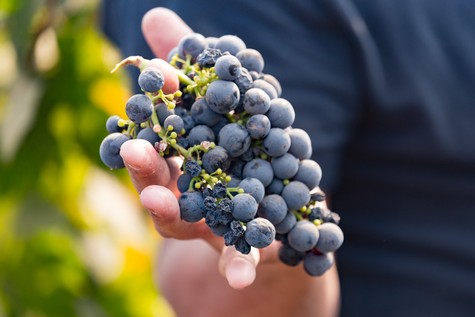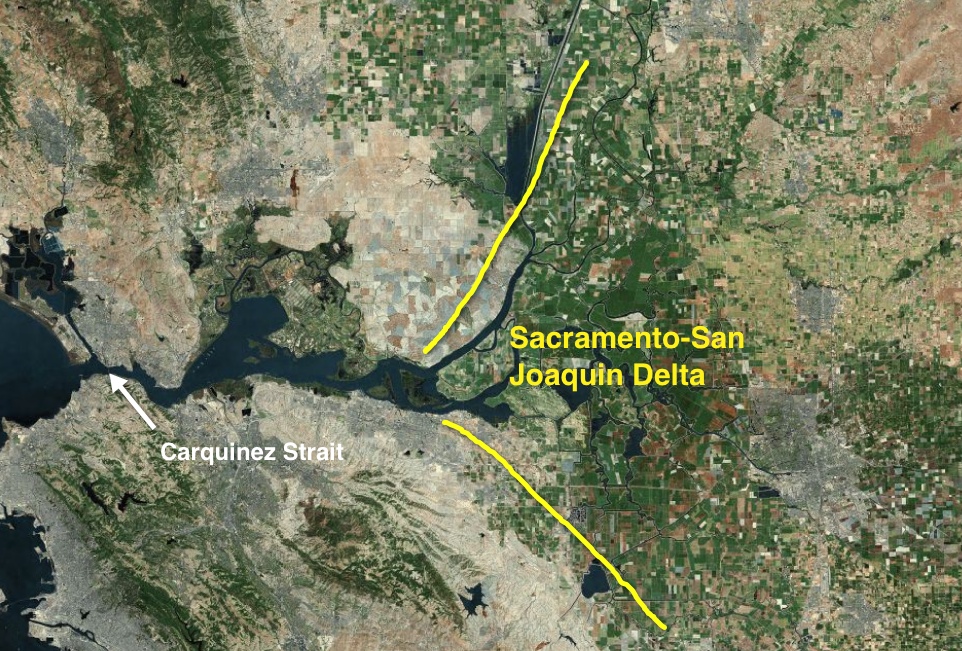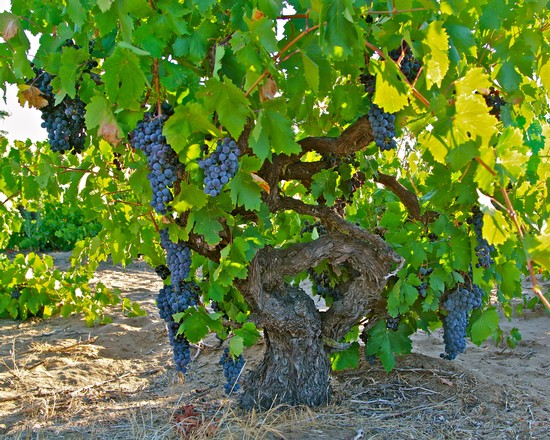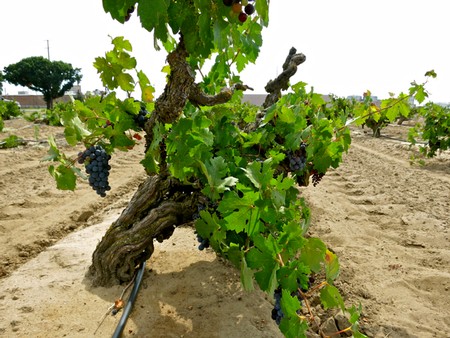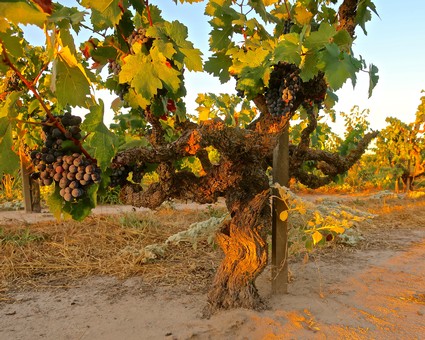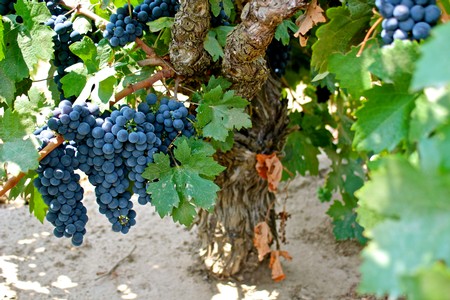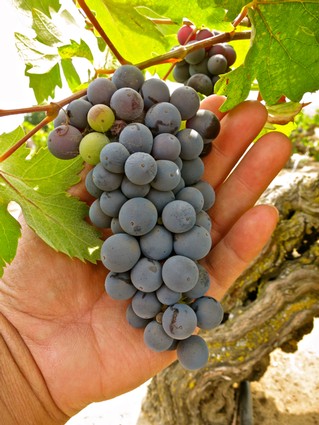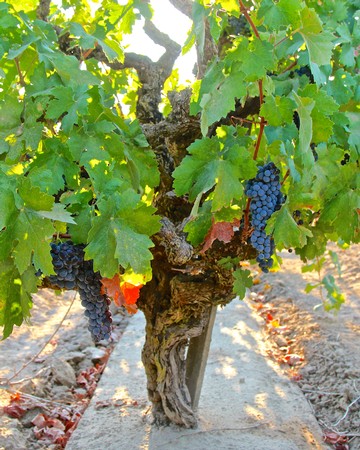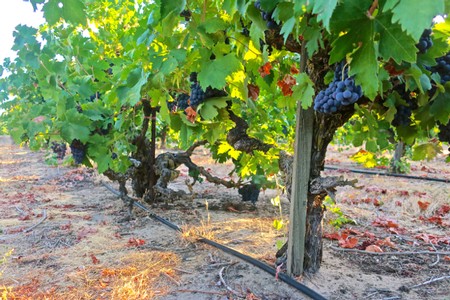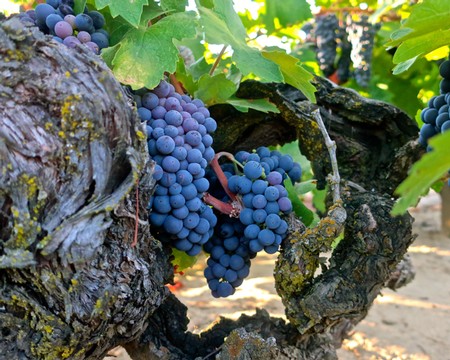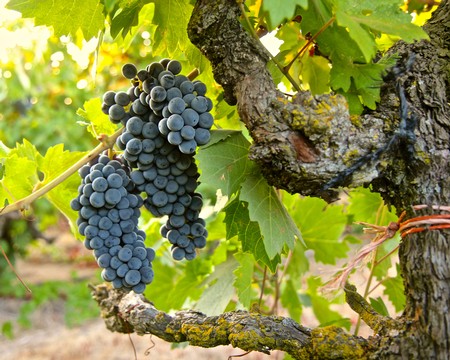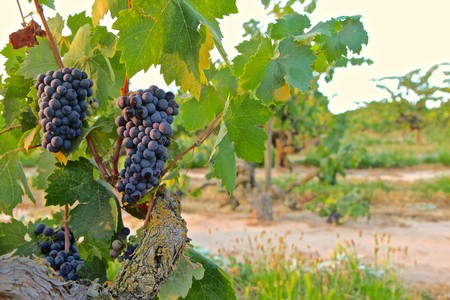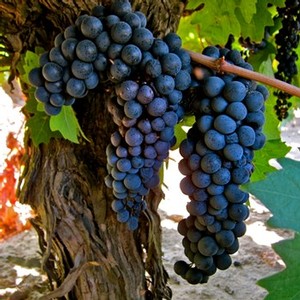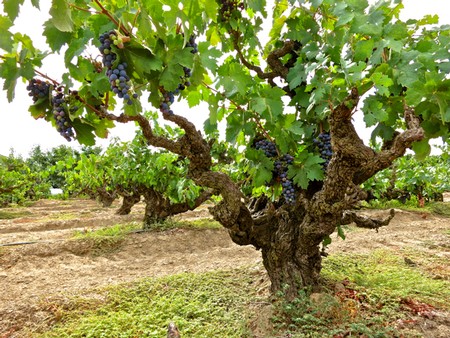Letters from Lodi
An insightful and objective look at viticulture and winemaking from the Lodi
Appellation and the growers and vintners behind these crafts. Told from the
perspective of multi-award winning wine journalist, Randy Caparoso.
Pictorial guide to what makes Lodi Zinfandel so unique
Note the small, loose berried Zinfandel cluster from the +100-year old Noma Ranch Zinfandel, growing on its own natural roots in the porous beach sand-like soils of Lodi/Mokelumne River’s east side
So you think you know Lodi Zinfandel? If you are ready to get your geek on, let’s delve into the six major reasons why Lodi grown Zinfandels are the way they are: so compellingly lush, round, gentle, bright, and often distinctly earthy…
1. Moderate Mediterranean climate influenced by cool coastal winds blowing through the Sacramento-San Joaquin River Delta
2. Very porous yet rich, sandy loam soil (in Tokay series) on mostly lower lying, flat to gently sloped topography
3. Choice of planting practices (most of Lodi’s older Zinfandel plantings are cultivated as head trained “goblets”)
4. Choice of rootstocks (most of Lodi’s older Zinfandel plantings are actually ungrafted – that is, growing on their own natural roots)
5. Sheer age of the vines (most of Lodi’s Zinfandel plantings are between 40 and over 100 years old)
6. Subtle clonal variations (especially in older vineyards with larger percentages of replanted vines).
All these things add up to one thing: a distinct Lodi terroir, or “sense of place.” In fact, Zinfandel has found such a comfortable home in the Delta, Lodi now crushes about 40% of California’s yearly crop of the grape – more than any other region in the state.
Lodi’s Mediterranean climate is influenced by direct proximity to cool air flowing in from the coast through the Carquinez Strait and the zero-elevation Sacramento-San Joaquin River Delta
But truth be told, it has only been within the past 10 years that there have been enough artisanal wineries producing single-vineyard bottlings to give us a firm idea of the terroir characterizing this vast American Viticultural Area (encompassing 644,500 acres, of which over 101,000 acres are planted to some 100 variations of classic wine grapes classified as Vitis vinifera).
Terroir, by its original French definition, also refers to the sensory qualities in a given wine that are directly attributable to the entirety of environmental conditions in which the grapes going into the wine are grown. Although it is climate, soil and topography that effect terroir in the purest sense of the word, it is also generally acknowledged that human decisions long associated with winegrowing regions – that is, viticultural and, to some extent, winemaking traditions – are also part of what we perceive as “terroir” when we taste a wine.
Compare this large, vigorous Rous Vineyard vine, planted in 1909 on St. George rootstocks, to the own-rooted Noma Ranch Zinfandel below…
While growing in very similar, east side Lodi sandy soil as Rous Vineyard, the bonsai-like size and stunted cane lengths of this own-rooted head trained Noma Ranch Zinfandel is also due to the fact that this vineyard has been largely dry farmed over the past 100 years
In Lodi, for instance, the largest percentage of Zinfandel plantings consists of free standing (i.e. untrellised), spur pruned vines that are either head trained (in the classic gobelet or "goblet" style) or on vertical cordons (where spurs are layered on one upright trunk). Most of those vines are planted on their own natural roots rather than on rootstocks selected for their resistance to Phylloxera vitifoliae – the root louse that wiped out most of the world’s vineyards planted on their own vinifera roots towards the end of the nineteenth century. The reason most of Lodi’s winegrowing pioneers deliberately chose to eschew phylloxera-resistant native American rootstocks such as Vitis rupestris (commonly known as “St. George”) is because most of Lodi’s Zinfandel is planted in the sub-AVA of Mokelumne River – the historic center of Lodi, defined primarily by its deep sandy loam soils. It has long been known that phylloxera does not proliferate in porous sandy soils, where plants are forced to develop stronger, deeper rooting systems to find water (this is why ungrafted Vitis vinifera is found only in the few other wine regions of the world dominated by sandy soil, such as Chile’s Valle Central and a few pockets of Washington’s Columbia Valley, California’s Contra Costa, San Luis Obispo and Santa Barbara).
Ergo: the choice of cultivating mostly ungrafted head trained or vertical cordoned Zinfandel has always been as much a part of what defines Lodi’s terroir as the region’s Mediterranean climate and sandy loam soils. Whereas in the rest of California – counties like Sonoma, Napa, Mendocino, Amador and Paso Robles – St. George was the most popular choice of rootstock for head trained Zinfandel during most of the twentieth century, in Lodi plantings on St. George have been known to result in increased vegetative growth and yields — not completely necessary in Lodi’s alluvial soils, already fairly rich in organic matter.
While also own-rooted, this Mohr-Fry’s Marian’s Vineyard Zinfandel (planted in 1901) is thought to be larger (and yielding fuller clusters) because of both clonal differences and a longer history of irrigation
The thick growth (in trunk, foliage and cluster morphology) of this 97-year old Soucie Vineyard vine is attributable to the vineyard’s location on the far west side of Lodi (near the Delta sloughs), where the sandy soil is richer in organic matter
Rous Vineyard, for instance, was planted on St. George rootstocks in 1909, and remains among Lodi’s most productive 100-plus year old Zinfandel plantings today. Although quantity in the field does not equal quality in the bottle, the fact that Rous Vineyard Zinfandels (produced by Macchia and Ironstone) are also among the state’s finest is probably attributable to the sheer age of the vines – another major factor defining Lodi’s terroir. Deep rooted ancient vines, after all, are venerated precisely because they tend to grow a healthier balance of fruit and canopy — hence, higher quality fruit — year in and year out.
Lodi Zinfandel plantings on “Dog Ridge” (Vitis champini) rootstocks have been known to grow even heavier canopies and weightier clusters – better suited for high production winegrowing. Maley Bros., one of the largest Zinfandel growers on Lodi’s west-side, cultivates 40 to 55-year old spur pruned vertical cordon vines on Dog Ridge as well as St. George. Vineyard manager Todd Maley, as well as winemakers Chad Joseph (who crafts wines for Maley Bros.), Tim Holdener (Macchia) and Layne Montgomery (m2), consider the St. George-rooted Wegat Vineyard to be Maley’s finest, and the high-vigor Maley plantings on Dog Ridge are considered less desirable.
Close-up of typically tiny cluster from the tiny vines in Noma Ranch
A more elongated, loose cluster typical vertical cordon vines in Maley Vineyard, most likely due to a clonal variation
Finally, there is the sixth major factor contributing to the quality and characteristics of Lodi grown Zinfandel: clonal variation. Differences among Zinfandel clones are the least understood of factors – probably because documented research in this area really date back only to 1995, when U.C. Davis initiated the first phase of its Zinfandel Heritage Project: starting with 80 Zinfandel selections culled from 50 vineyards in 14 counties in California, planted in the Oakville Experimental Vineyard in Napa Valley and utilizing consistent protocols (such as head trained vines grafted to St. George rootstocks).
The Zinfandel Heritage Project – in part, funded by yearly ZAP (Zinfandel Advocates & Producers) events – is just now entering a third phase, in which 22 selections will be planted under the same controls in Dry Creek Valley, Sonoma Valley, Paso Robles and Lodi. In a recent report delivered to ZAP by U.C. Davis professors Jim Wolpert and Mike Anderson, it was noted that varieties like Zinfandel are not nearly as prone to genetic mutation as, say, Pinot noir; evidenced by the fact that there are no white (blanc) or gray (gris) cultivars of Zinfandel in existence (in contrast to Pinot noir, with its well known Pinot gris and Pinot blanc off-shoots).
In Lizzy James, shorter, scraggly head trained vines planted in 1901 (above, to left) are interplanted with younger, more vigorous vines on vertical cordons planted in the 1970s (right)
Compare the smaller clusters (above) on the 109-year old Lizzy James vine to the larger, weightier clusters on the young Lizzy James vine below…
The heavier clusters on this young Lizzy James vine is due to both vine age and differences in clonal selection
Still, it has long been observed in Lodi that certain vineyards, such as Maley Bros.'s Wegat Vineyard and Noma Vineyard on Victor Rd., are dominated by vines that produce smaller, looser clusters, usually with smaller sized berries. Other vineyards, like Harney Lane’s celebrated Lizzy James Vineyard, consist of vines planted as far back as 1904; but roughly half the vineyard consists of replants put into the ground during the 1970s, many of them yielding slightly different cluster morphology from that of the oldest plants – differences due mostly to different clonal and rootstock selections (Lizzy James’ original vines are own-rooted).
Generally speaking, smaller, looser Zinfandel clusters have always been considered more suitable to higher quality wine production: first, because they are less prone to bunch rot (because tightly packed, heavier clusters are prone to bunch rot, they are not capable of hanging on the vine as long to develop intense varietal character); and second, because smaller berried clusters do tend to develop a more desirable balance of soluble solids (especially Brix sugar readings), organic acids, pH, and the phenolics and anthocyanins that contribute to color, flavor and texture.
The cluster morphology in Mohr-Fry’s Marian’s Vineyard tends to be weighty, large berried yet intensely flavorful — quintessentially “Lodi”
Clusters in the 97-year old Soucie Vineyard have the classic weight, generous flavor and strongly earthy complexity typical in Lodi
This much we know: there are visibly different cluster architectures in the best parts of Lodi’s most highly regarded vineyards. At the same time, how much of the differences are due to actual clonal variation, or vine age, choice of rootstock, or small differences in physical terroir (the sandy loams on the east side of the Mokelumne River AVA, for instance, are known to be deeper and more well drained than the sandy loams on the west side) – we’ll probably never really know with absolute certainty. Differences related to Lodi’s terroir, like in all the great wine regions of the world, is a complexity of intertwining factors – observable from vineyard to vineyard, block to block, row to row, and from plant to plant.
The important thing is knowing that distinct Lodi terroirs exist. This is why Rous Vineyard Zinfandels are so flowery and gentle, Noma Ranch Zinfandels are so high in acid yet full throttled, Mohr-Fry Marian’s Vineyard Zinfandels are so deep and bosomy, Lizzy James Vineyard Zinfandels are so refined and multi-faceted, Soucie Vineyard Zinfandels are so lush yet downright earthy, and Maley’s Wegat Vineyard Zinfandels are so round and “voluptuous”… so many wonderful sensations we are now beginning to clearly delineate, and appreciate, in Lodi’s finest wines.
The medium-weight clusters on this 104-year old Rous Vineyard vine is probably due to vine age as much as clonal selection and the vineyard’s planting on St. George rootstocks
